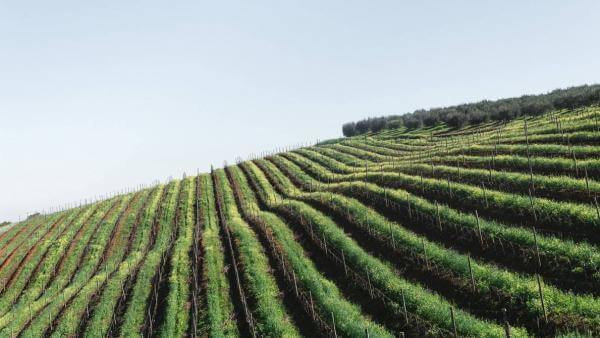Starting any business is a monumental task. And starting a winery or vineyard is certainly no exception. Vines are notoriously finicky; a volatile growing season can wipe out an entire vintage. The acerage necessary for growing the best winemaking grapes is also expensive. Plus, you’ll need large equipment and space for a bar, gift shop, and restaurant.
Today, we’ll go over some of the basics of how to start a winery. As with any job this big, a blog post will necessarily be far from exhaustive, but hopefully, this will give you some ideas or inspire you to do further research.

How to Start a Winery- THE KEY TAKEAWAYS
- Determine your winery type: Decide whether you will grow grapes, produce wine, host guests, or offer a combination of these activities.
- Conduct a thorough site selection: Choose a location with suitable climate, soil conditions, and topography for growing grapes if you plan to have a vineyard.
- Develop a strong business plan: Secure financing by creating a comprehensive business plan that outlines expenses, revenue projections, and strategies.
- Obtain necessary licenses and permits: Apply for federal and state licenses, permits, and registrations required for operating a winery.
- Invest in essential equipment: Acquire equipment like crushers, presses, fermentation vessels, barrels, and bottling machinery for wine production.
STEP-BY-STEP GUIDE TO OPENING A WINERY
A passion project such as this one is always exciting. And that first beautiful glass of wine at the finish line probably keeps you racing ahead. Unfortunately, there are some steps that must be taken early on to ensure that your winery will be a hit.
1. What type of winery will you have?
The first step is determining what kind of winery you’d like to have. There are a surprising number of options here. At the most basic level, there are three levels of production: growing the grapes, producing the wine, and hosting guests at the winery.
Many wineries choose some combination of these three. Will you grow your own grapes or order them from farmers? Or a combination of the two? Some outsource grapes for the first few years while the new vines mature. Will you run production yourself? Or you could skip the growing and the production and just host tasting events and sell your delicious wine.
2. Scout potential locations
Your options will be limited if you plan to grow the grapes yourself. Winemaking grapes are fragile and fussy. They grow well only in highly specific climates and soils. At this stage, the land could be your backyard or a 2,000-acre farm, but wherever you’re looking, it must be hospitable to your precious grapes. If you plan to buy grapes from existing farms, you’ll be provided more flexibility, though choosing the right spot will be just as critical for your future success.
3. Put together a business plan
Most aspiring vintners will need a loan to get off the ground. A retail business plan is essential for securing small business loans, especially one as substantial as a winery requires. Research is critical at this stage. Don’t be shy; ask other winemakers to share their experiences. Based on your location and planned amount of production, ballpark your total expenses and revenue. Here’s a simple example of a winery business plan.
4. Register your winery business
Identify the government agency responsible for business registration in your area. This may be a local, state, or national agency, depending on your location. In the United States, for example, this is often done at the state level.
5. Obtain an Employer Identification Number (EIN)
If your winery business is in the United States, you’ll need to obtain an EIN from the Internal Revenue Service (IRS). This is necessary for tax purposes and may also be required for other business activities.
6. Contact the federal alcohol and tobacco Tax and Trade Bureau (TTB)
The TTB is the federal agency responsible for regulating the alcohol industry, including wineries. You’ll need to apply for and obtain a federal basic wine manufacturing permit from the TTB.
There are four options mentioned by the TTB before entering the wine industry: bonded winery, alternating proprietor, custom crush client (Wholesaler), and the bonded wine cellar. Each one of these options has its specific requirements, and you’ll have to visit the federal application process for the wine industry to get more information.
7. Get necessary state licenses and permits
The federal basic wine manufacturing permit and other permits you’ll get from the TTB are the federal permits. In addition to them, you’ll need state licenses and permits. You should apply for and obtain a winery license from your state’s alcohol beverage control agency. You’ll also have to obtain other necessary state and local permits, such as a sales tax permit, zoning approval, and health department permits.
8. Open a business bank account
Opening a business bank account for a winery is a crucial step in separating your personal and professional finances. Unlike personal accounts, business accounts are designed to separate personal and business finances, helping maintain clear financial records and facilitating tax filings.
When setting up a business bank account for a winery, it’s important to consider additional services like a merchant account. A merchant account enables the winery to accept credit and debit card payments, crucial for modern business transactions.
Merchant services associated with the account offer features such as payment processing, fraud protection, and transaction reporting, streamlining the winery’s financial operations and enhancing customer convenience.
9. Get business insurance
Running a winery business involves various risks, making it crucial to have appropriate insurance coverage. Some essential types of insurance that a winery should consider are listed below:
- Property insurance: This covers physical assets such as buildings, equipment, inventory, and supplies against risks like fire, theft, and natural disasters.
- Product liability insurance: Wineries need this coverage to protect against claims of injury or illness caused by their products, such as allergic reactions or contamination.
- Liquor liability insurance: Crop insurance is essential for vineyards, offering financial protection in the event of crop loss due to adverse weather conditions or other unforeseen circumstances.
- Workers’ compensation insurance: This coverage is mandatory in most states and provides benefits to employees who sustain job-related injuries or illnesses.
GROWING THE GRAPES
When starting a winery, selecting the perfect grape variety is like picking your leading actor. It sets the stage for the entire production and shapes the identity of your wines. There are a few families of grapes that are most commonly grown on vineyards. Below are a few examples:
- Vitis vinifera: This is the classic European wine grape, considered the king of wine grapes. It represents the vast majority of wine grapes grown worldwide and includes popular varieties like Cabernet Sauvignon, Chardonnay, Merlot, Pinot Noir, Sauvignon Blanc, and Zinfandel. These grapes are known for their thin skins, high acidity, and complex flavor profiles.
- Vitis labrusca: These are native American grape varieties known for their distinct foxy or musky flavor. Concord and Isabella grapes are well-known examples of this category. While not as widely used in premium wines, these grapes are popular for making juice, jams, and jellies, and some wineries are experimenting with creating unique wines from them.
- Vitis rotundifolia: Also known as Muscadine grapes, these are native to the southeastern United States. They are known for their thick skin, high sugar content, and pronounced musky flavor. Scuppernong and Carlos are examples of Muscadine grapes. Similar to labrusca grapes, they are not widely used in high-end wines, but are gaining some interest in specialty wines and for their disease resistance.
Regardless of whether you choose to grow your own grapes or outsource them, it is crucial to conduct thorough research on the grape varieties best suited for your desired wine styles and the specific terroir of your winery location. Consider consulting with viticulturists, winemakers, and experienced growers to gain insights into the nuances of grape growing and winemaking in your region.
If you plan to buy your grapes from someone else, you can skip to the next section unless you want to hear about how outrageously difficult grapes can be.
1. Analyze your climate
When do the first and last freezes come? Vines should typically be planted after the last freeze, and grapes harvested before the first. How many days of sunshine does your area get? Ideally, temperatures never hit extremes: warmer nights and cooler days.
2. Survey your land
Not only do your vines like PERFECT weather, but they also like slopes. Particularly south-facing slopes since those get more direct sunlight. Don’t worry, your fastidiousness will pay dividends in the end.
3. Choose the right soil
As you might expect, vines require a more acidic soil and one that is not too nutrient-rich. They prefer to live on the brink of peril in every way possible. Unsurprisingly, most also thrive in rocky soils that drain easily.
4. Determine how many vines you want
Generally, vines should be planted 4-6 feet apart from one another so that they never shade each other. Oh yeah, they hate shade as well. Rows should be about 6 feet apart. On average, you need 20 lbs of grapes to produce a gallon of wine. A healthy vine should produce about 5 lbs of grapes per season. Brush up on your Algebra I and calculate how much wine you’d like.
5. Choose your varietals
There are 6,000 different varietals native to Italy alone. You have options. Some, of course, will not be suitable for your climate, but many will be. Choose vines that will thrive and bear many delicious grapes.
6. Buy your vines
There are many companies that sell one-year-old vines. These are mature enough to be planted right away and should start bearing fruit in the next year or two. Research different companies and inspect the vines for any signs of stress, fungus, or rot. Also, be sure that the vines are certified as one year old – some purveyors will try to toss in older vines that were not sellable the prior year and therefore might not do well when transplanted.
7. Plant them!
Dig holes that are about a half foot wide and less than a half foot deep. Set up a basic trellis system to give them support as well. This doesn’t have to be as fancy as those in Napa; some basic wire will do the trick.

RUNNING YOUR WINERY
So what about the winery itself? No matter what levels of production you’ll be handling yourself, selling the wine is your ultimate job.
1. Start marketing early
Winemaking and selling are competitive, and entry to the market isn’t as prohibitive as it might seem. It is essential to figure out your niche in the market and how you can uniquely brand yourself.
2. Follow local, state, and federal regulations
Like any business that deals with alcohol, you will have to deal with a vast amount of licensing and paperwork. Register your business with the ATF and complete all required licensure with your city and state.
3. Plan for distribution
If you will be growing enough to sell outside of your area, figure out feasible options for distribution, including online wine sales. Wine is difficult to please off the vine as well and needs to be transported carefully.
4. Design the winery and retail space
This can come in many shapes and sizes. And again, it doesn’t have to look like a scene from Sideways. Put thought into the layout of the space and how many people it could host. There are plenty of ways to get creative with some of your retail marketing strategies.
5. Set up a wine club
Wine clubs are an easy way to get people in your doors and promote your product. Most people like to look for guiltless excuses to drink wine, and a local club is a perfect one. It’s a good way to integrate yourself with the community as well. Check out this guide to wine-tasting club supplies.
6. Just a winery?
Will you have food service or serve other beverages? What about hosting events? Figure out what other areas of operation your small business will be.
7. Choose your winery point of sale system
When it comes to choosing a winery point of sale system, there are several factors to consider to ensure it meets the specific needs of your winery business. Here are some key points to evaluate:
- Industry-specific features: Look for a POS system designed specifically for wineries. The best POS system for wineries will likely include features like wine club management, tasting room management, inventory tracking for different vintages and blends, customer relationship management (CRM) tools for wine clubs, and integration wine delivery tools.
- Scalability: As your winery grows, you’ll want a winery POS system that can scale with your business. Look for a system that can handle increased transaction volumes, additional locations, and expanded product offerings.
- Reporting and analytics: A robust reporting and analytics module is essential for tracking sales, inventory levels, customer data, and other key metrics. This will help you make informed business decisions and identify trends.
- Customer management: Look for a system that allows you to capture and manage customer information, including wine club memberships, purchase history, and preferences. This can help you personalize your marketing efforts and improve customer loyalty.
- Cost: POS systems can range in price from a few hundred dollars per month to several thousand dollars per year. There may be upfront costs for hardware as well. Ensure your winery POS system does not tie you into crazy contracts and fees. That’s why it’s always advisable to look for a POS that can integrate with any payment processing solution.

Learn more about how credit card processing works and save your business money in this free eGuide.
What Equipment Will You Need to Start a Winery?
Starting a winery involves several key pieces of equipment to ensure the successful production of wine. Here is a list of essential equipment for setting up a winery:
- Grapes or grape juice source: Access to quality grapes or grape juice is fundamental. Consider establishing relationships with vineyards or grape suppliers.
- Grape crusher and destemmer: This machine is used to crush and remove the stems from the grapes. It’s the first step in the winemaking process.
- Press: A wine press is used to extract juice from the crushed grapes. There are various types, including basket presses and bladder presses.
- Fermentation vessels: These containers are where the grape juice undergoes fermentation. Options include stainless steel tanks, oak barrels, or other food-grade vessels.
- Temperature control equipment: Maintain the right fermentation temperature using cooling or heating equipment to control the process and achieve desired flavors.
- Pumps and hoses: Necessary for transferring wine between tanks, barrels, and other containers.
- Barrels: Oak barrels are often used for aging wine, imparting flavors and aromas. They come in various sizes and can be new or used.
- Racking equipment: Racking involves transferring wine from one container to another, leaving sediment behind. Siphons, tubing, and racking wands are common tools for this process.
- Laboratory equipment: Instruments like hydrometers, pH meters, and titration kits are crucial.
- Waste management system: Develop a system for disposing of grape skins, stems, and other by-products generated during winemaking.
- Tractor and grape harvester (for vineyards): If you have a vineyard, you may need a tractor and grape harvester for efficient grape harvesting.
- Tasting Room Equipment (if applicable): If you plan to have a tasting room, you’ll need glasses, spittoons, furniture, and other amenities for visitors.
Remember that the specific equipment you need can vary based on the scale of your winery, the types of wine you plan to produce, and your production methods. It’s advisable to consult with experienced winemakers or industry experts when setting up your winery.
How Much Does it Cost to Open a Winery?
Opening a winery can be a capital-intensive venture which is why it’s key to calculate the upfront costs of opening up your winery beforehand. Typical startup costs range from $500,000 to $1 million or more, depending on factors like the size of the operation, land acquisition, equipment, permits, and construction costs for facilities like tasting rooms and production areas. Ongoing expenses like labor, marketing, and distribution can also be significant. Careful financial planning and a solid business strategy are essential for success in this competitive industry.
How Much Winery Owners Make: Is Owning a Winery Profitable?
According to FinModelsLab, small wineries producing less than 5,000 cases a year typically bring in an average owner income of $70,000 – $100,000. Larger wineries, exceeding 50,000 cases annually can see profits over $1 million for the owner.
Starting a Wine Shop
Rather than cultivating grapes and producing wines in-house, starting a wine shop involves curating a carefully selected assortment of wines from various vineyards and regions. The focus here lies not only on providing a diverse and high-quality collection but also on creating an immersive and educational experience for customers.
Running a wine shop relies on developing a discerning palate and fostering relationships with reliable suppliers. It offers exclusive tastings to expertly paired cheese and charcuterie selections, creating an inviting ambiance that caters to casual enthusiasts and connoisseurs.
The aim is to offer a haven for wine enthusiasts seeking a personalized and memorable journey through the world of fine wines. You’ll need a well-curated inventory, knowledgeable staff, and a dedication to exceptional customer service.
How to Start a Winery with KORONA POS
One crucial in starting a winery is selecting the right POS system to manage your operations efficiently. KORONA POS is a versatile retail POS solution that caters specifically to the needs of wineries.
With its ability to integrate seamlessly with any payment processor, KORONA POS ensures a smooth transaction process for your customers. Moreover, it offers features tailored to the wine industry, such as a dedicated wine-tasting room module. This module streamlines the tasting experience, allowing customers to sample your offerings and easily purchase their favorites.
KORONA POS also provides inventory management software, making it easier to track your wine production, bottling, and sales, ensuring you never run out of stock for your most popular varietals.
KORONA POS offers table management, graphical table layouts, time tracking tools, and many more. Click below to learn more about how KORONA POS can help your winery business.












